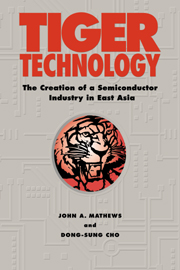Book contents
- Frontmatter
- Contents
- List of Figures
- List of Tables
- Preface
- Abbreviations
- Introduction
- Part I The ‘Real’ East Asian Miracle
- Part II National Institutional Pathways
- 3 The Tangun Boom and the Chaebol: How Korea Did it
- 4 A Cat Can Look at a King: How Taiwan Did it
- 5 Jack and the Beanstalk: How Singapore and Malaysia are Doing it
- Part III The Technology Leverage Strategy
- Appendix I Exchange Rates: 1975–97
- Appendix II Chronolog
- Glossary
- Bibliography
- Index
5 - Jack and the Beanstalk: How Singapore and Malaysia are Doing it
Published online by Cambridge University Press: 09 October 2009
- Frontmatter
- Contents
- List of Figures
- List of Tables
- Preface
- Abbreviations
- Introduction
- Part I The ‘Real’ East Asian Miracle
- Part II National Institutional Pathways
- 3 The Tangun Boom and the Chaebol: How Korea Did it
- 4 A Cat Can Look at a King: How Taiwan Did it
- 5 Jack and the Beanstalk: How Singapore and Malaysia are Doing it
- Part III The Technology Leverage Strategy
- Appendix I Exchange Rates: 1975–97
- Appendix II Chronolog
- Glossary
- Bibliography
- Index
Summary
In the mid-1980s, when the US and Japan were struggling for world supremacy in semiconductors, and Korea and Taiwan were making their first moves into the industry, the South East Asian countries Singapore and Malaysia were following a quite different trajectory. Lacking anything like the technological sophistication of their North East Asian neighbours, these countries sought to leverage themselves up the technology ladder by attracting investments from multinational corporations (MNCs) – and indeed had some success in this endeavour, particularly in semiconductor packaging and assembly, and electronics.
But the strategy these countries had been pursuing appeared to unravel in the mid-1980s. Impressive as their industrial output was, it was produced by multinationals rather than by domestic firms – and the activities were decidedly at the low-technology end of the spectrum. Then amidst a worldwide electronics industry recession, the multinationals cut back investments in both Singapore and Malaysia, underlining the vulnerability of the countries. With high wages being advocated by the government in each country as part of a social justice campaign focused on the multinationals, local enterprises found themselves squeezed.
It was out of this crisis that new policies and programs were developed which have resulted in a sustained period of growth and industrial upgrading in Singapore and Malaysia, and a breakthrough by both into the most sophisticated ‘front end’ of the semiconductor industry, namely wafer fabrication. The activities are carried out at three dedicated wafer-fabrication industrial parks in Singapore, and at the Kulim high-technology park development in Kedah, northern Malaysia.
- Type
- Chapter
- Information
- Tiger TechnologyThe Creation of a Semiconductor Industry in East Asia, pp. 203 - 244Publisher: Cambridge University PressPrint publication year: 2000



